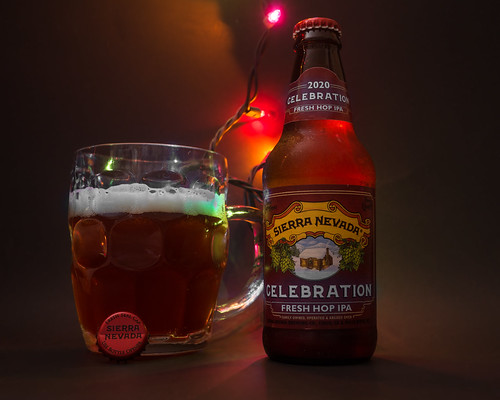I began this damnable year with a beer. Let me end it likewise but with a celebration for a better year, next.
Sierra Nevada Celebration Ale
— Sierra Nevada Brewing Company
Chico, California / Mills River, North Carolina.
The brewery released the beer in mid-October 2020 for the winter season. My particular bottle —which I purchased and sampled (uhh, drank) on Christmas Eve, 24 December 2020— the brewery had packaged on 16 October.
From the bottle's label:
Fresh hop 1 IPA.
6.8% alcohol-by-volume.
We first brewed Celebration IPA in the winter of 1981. Each year, we use only the first fresh hops of the growing season to create this complex and robust ale. Layered pine and citrus hop aromas balance delicately against rich malt sweetness to shape this bold, wintertime classic.
From me:
Bright hops, citrusy and piney, chased by an off-dry biscuity middle and a white pepper finish. Two months after bottling, the hop aroma might have been a bit diminished but not the overall hop presence and not the firm malt backbone. Indeed a holiday celebration.
And, so, to all my readers: Linksmų Kalėdų tau ir tavo! (On the off chance you're not fluent in Lithuanian, that's "Happy Christmas to you and yours!") 2
-----more-----
- 1 What is a fresh hop beer (other than what you might naturally assume)?
Wet hopping [or, now, the more often used "fresh hop," such as for Celebration Ale] is the process of using un-kilned, hence "wet," hops in brewing. In the Northern Hemisphere, [...] hops are generally harvested August through September. Wet hops are approximately 80% moisture. [...] If left too wet, baled hops may "sweat,' become moldy, and develop off aromas. When brewers use hops wet, therefore, they [the hops] must be shipped via the fastest method straight to the brewery, where they are used immediately. [Fresh hop beers] have emerged largely [since the aughts] and are almost exclusively produced by American craft [breweries] located in hop-growing areas. [...] The reason behind such ["wet hopping"] is the desire to capture the hops' most delicate and volatile aroma oils in the finished beer. [...] Some beer enthusiasts enjoy the uniquely "gree" delicate character of these beers, while others are put off by the distinctly grassy chlorophyll-like aromatics.— The Oxford Companion to Beer: Oxford University Press, 2012.
- 2 This blogger is 3rd generation Lithuanian-American.
- Prior reviews of other beers (often presented in a blog feature called Drinking, Again!): here.
- Pic(k) of the Week: one in a weekly series of images posted on Saturdays, occasionally, as is the case today, with a good fermentable as the subject.
- Photo 52 (and final) of 52, for year 2020. See it on Flickr: here.
- Camera: Olympus OM-D E-M10 II.
- Lens: Lumix G 20/F1.7 II.
- Settings: 20 mm | 5 sec | ISO 200 | f/5.6
- Commercial reproduction requires explicit permission, as per Creative Commons.
- For more from YFGF:
- Follow on Twitter: @Cizauskas.
- Like on Facebook: YoursForGoodFermentables.
- Follow on Flickr: Cizauskas.
- Follow on Instagram: @tcizauskas.










No comments:
Post a Comment
Comment here ...